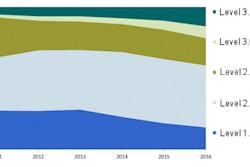
Managing documents is not a new issue, as document management systems were in place long before and have existed in parallel with PACS and other department information systems. Scanning and storing documents in a PACS or RIS, however, can cause all kinds of headaches.
Traditionally, many hospital departments have scanned documents into their respective systems to make them available to physicians. With regard to documents, there are two categories: medical record documentation that is essential for a physician to do his or her clinical job, and legal and regulatory documentation kept "just in case."
 Herman Oosterwijk of OTech.
Herman Oosterwijk of OTech.
Examples of medical records include the sheet that conveys the clinical measurements produced by a technologist when performing an ultrasound procedure; a requisition form that shows the reason for the study; or a diagnostic report from a previous study. The second category includes consent forms, HIPAA privacy release forms, and other such documentation.
The staff members charged with scanning in these forms range from the "front-desk" medical receptionist to specialists such as medical records technologists. The latter are usually found in larger institutions that have a document scanner next to the CT or MR operator's console.
Document scanning in radiology
How is this implemented? Let's take radiology, for example. For users who have PACS-driven systems, these documents typically are encapsulated with a DICOM header, and the capture station or software typically has access to the order so that the header can be populated with the same patient and study information. The formats are mostly the so-called "secondary capture" format, which can be thought of as a bitmap or screenshot.
There is also an option to scan the document as a DICOM-encapsulated PDF, which is used less often but has the advantage of being much more efficient and yielding smaller file sizes. The disadvantage of encapsulated PDF documents is that there could be PACS compatibility issues; all workstations may not be able to view them. These PACS-driven solutions make the documents available as part of the same study where the images reside, typically in a separate series, and they are stored in the PACS archive.
For users who have department-driven systems, where the worklist for the physician is created by a RIS or clinical information system, there is typically access to the department database. Therefore, the documents are scanned into the information system as files, which can be in JPEG, PDF, or other formats such as TIFF. These are indexed and managed by the departmental information system database.
Dedicated document management systems do have their own databases and archives, and they are often more sophisticated as they employ high-speed scanners, as well as software performing optical character recognition (OCR) to recognize patient demographics, which can be used to index the documents. Several institutions have worked on becoming totally "paperless" and have established dedicated departments for scanning in all patient documentation. See a related blog on certification of document administrators on this topic.
Becoming patient-centric
The problem with all of these solutions is that they create islands of patient documentation and are application- and/or department-centric instead of patient-centric. Two major developments, however, are driving a more patient-centric approach.
The first is the meaningful use requirement for electronic health record (EHR) implementation. The second development, which has been going on in parallel with meaningful use, is the trend toward a true enterprise or vendor-neutral archive (VNA). A true VNA should provide storage, management, and access to these documents.
So the best answer regarding where to store documents -- either in the RIS, in other department systems, or in the PACS -- is "none of the above," as these are short-term, dead-end solutions. Rather, investigate how your EHR manages documentation and how your enterprise archiving system stores and retrieves them. That is the only way to provide a long-term, patient-centric solution.
Herman Oosterwijk is president of OTech, a healthcare imaging and IT company specializing in EMR, PACS, DICOM, and HL7 training.



















